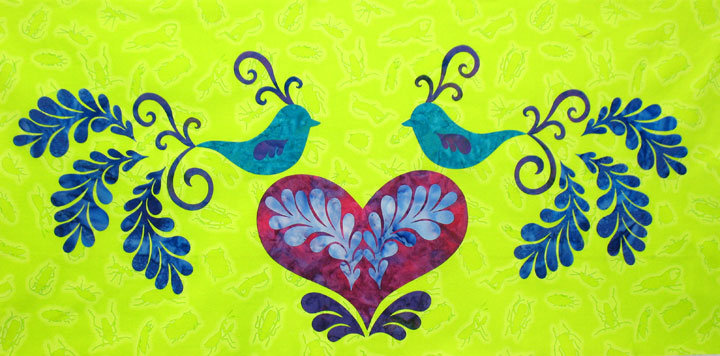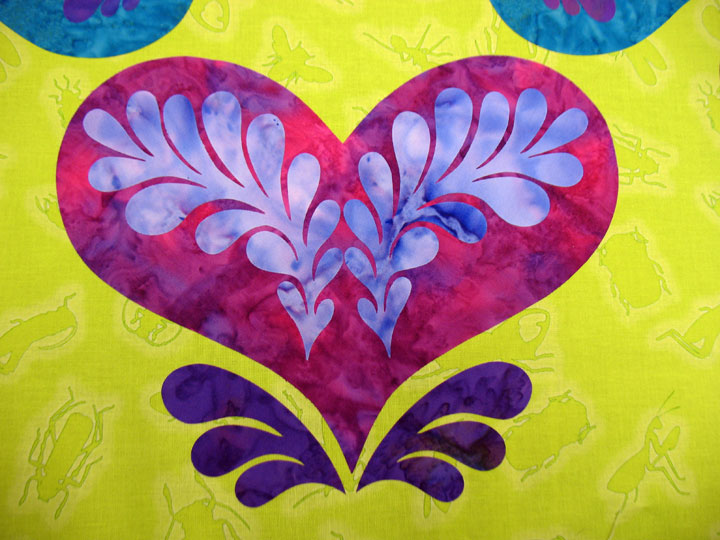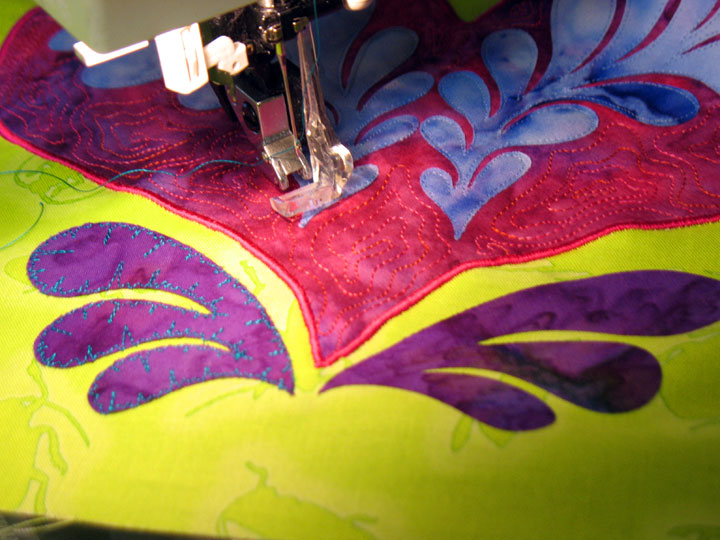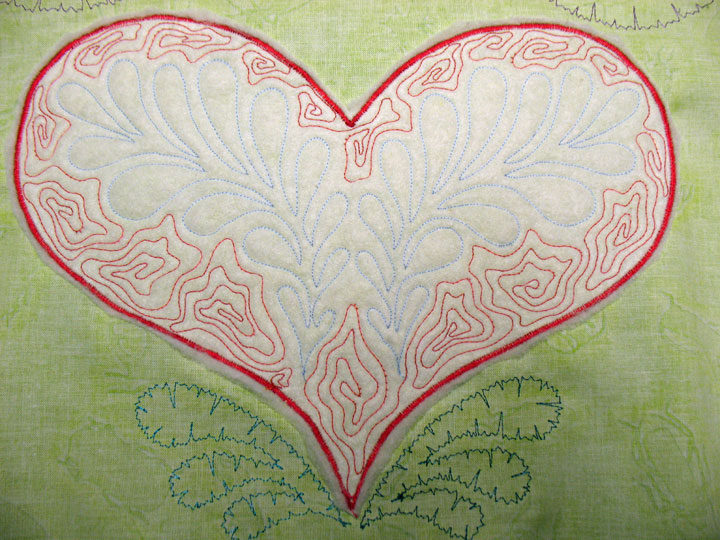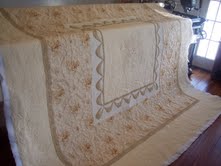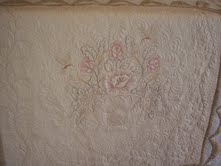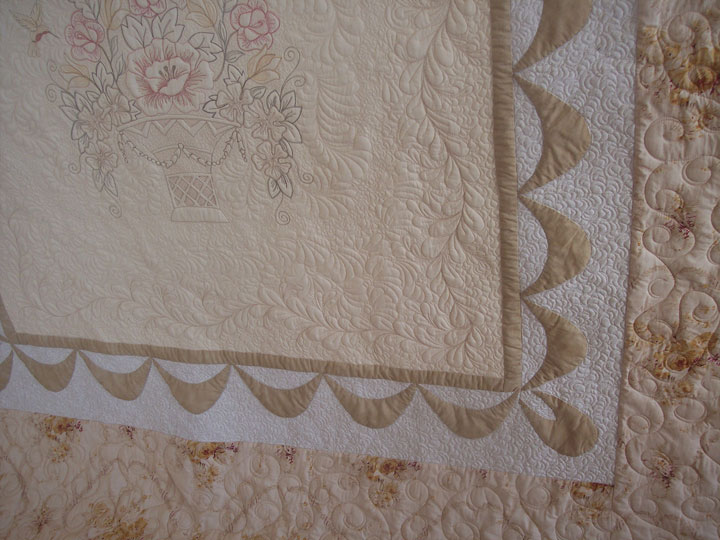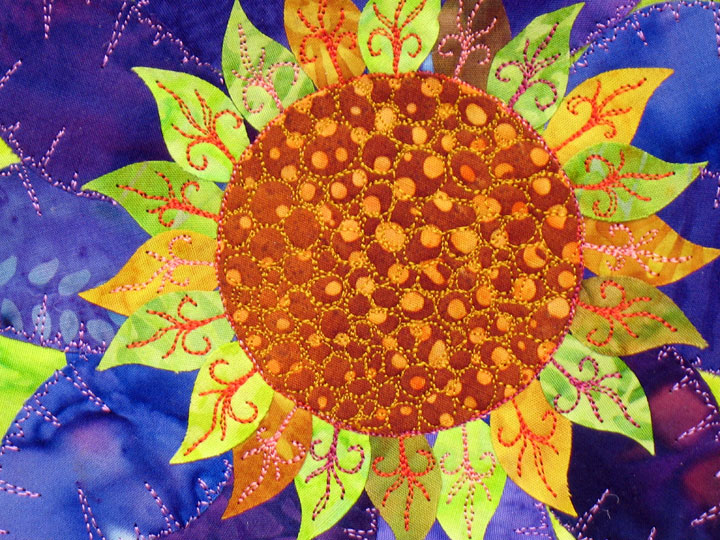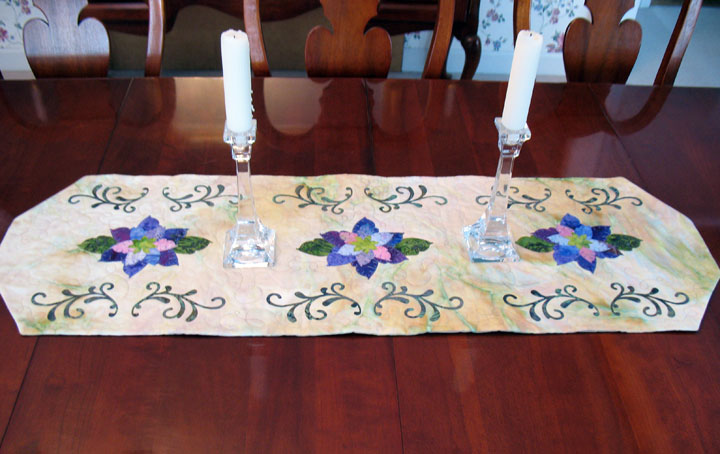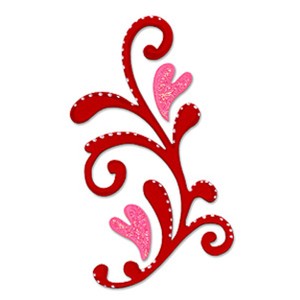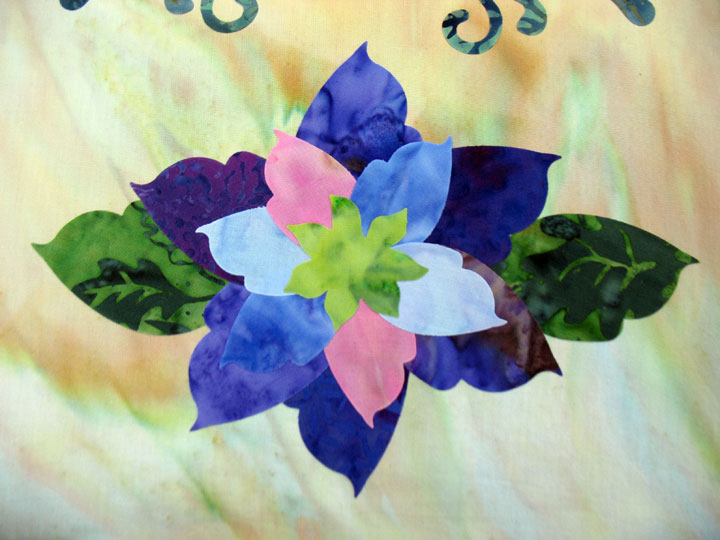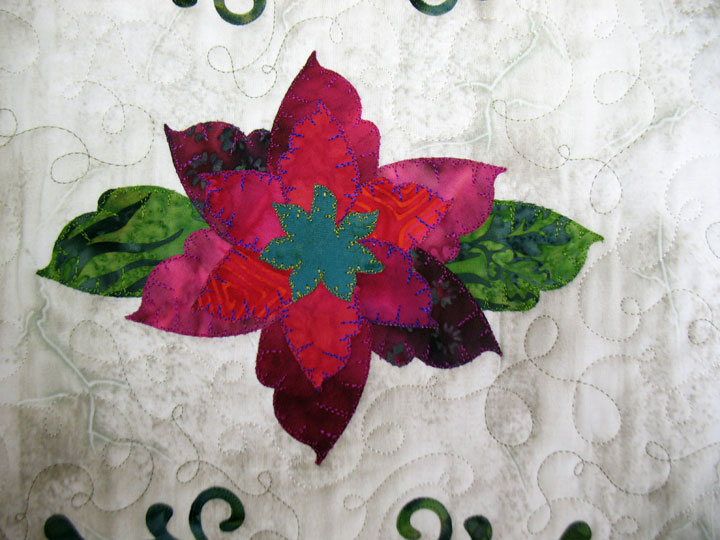January 12th, 2011
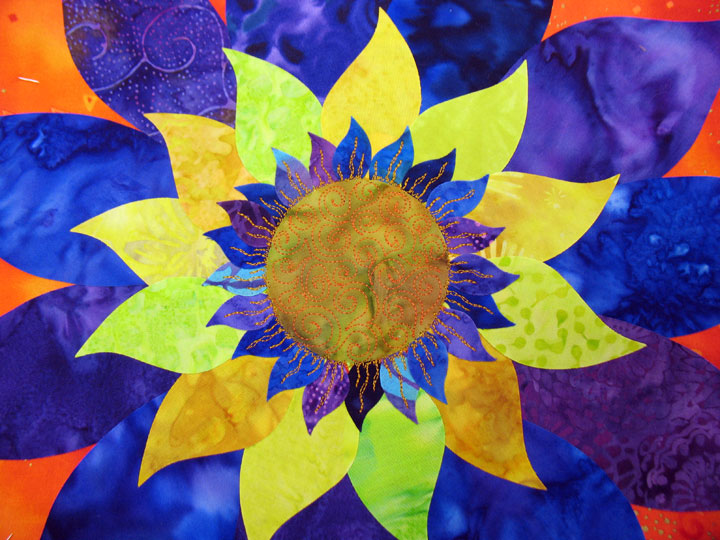
Hettie wrote:
I notice you did not stitch anything around the edges of your first row of petals where you stitched the gold swervy lines. Would these be secure enough to withstand washing in a machine?
Good question, Hettie! Remember that here, I am working only on a quilt block. At this stage, I am adding decorative stitching only to jazz up this piece and also to anchor the piece of scrap batting behind it. You are correct that I need to stitch around the outer perimeter of those inner petals to secure them fully, but I will wait until this block has been pieced into the full top and placed into the final quilt sandwich to do that stage of stitching. When I get to that stage, I’ll stitch around each individual piece of applique using invisible thread in my top needle. This will allow me to showcase the wonderful textural effects of the trapunto, as each applique piece will pop out a bit. Here is a photo of a smaller flower that has been trapuntoed:
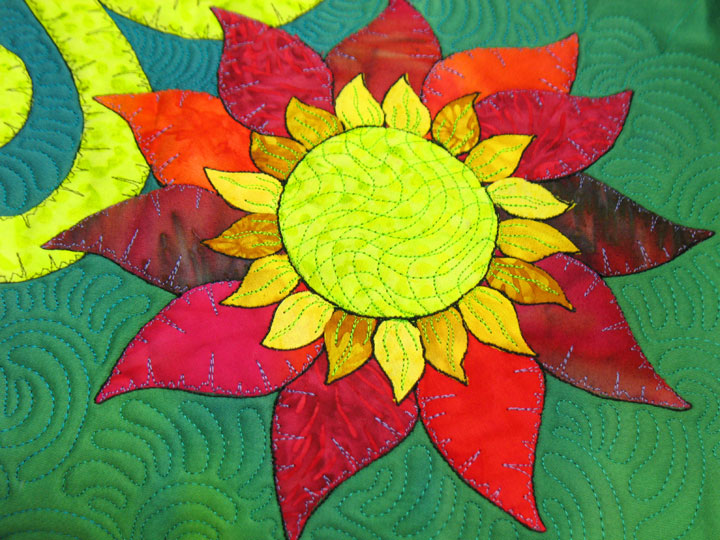
For this flower, I used a heavy solid black cotton thread to outline each individual piece. It makes each piece protrude out just a bit, but by using black thread, it also adds that cool, thin black line around everything. Another good example of how thread can really alter a piece!
Connie also wrote in a question about this large flower:
Beautiful background for your fantastic flower! I can’t remember if you mentioned this before but do you do free-motion when you do the zigzaggy edges or is that a special stitch on your machine? Always love seeing what you are working on!
The finishing stitch on the yellow petals are what she is asking about:

I call that edge finishing stitch the “EKG edge finishing design” since it looks like an EKG rhythm strip. It’s not a programmed stitch on my machine; it’s created by placing the machine in straight stitch, free motion mode and then gently rocking the quilt back and forth to create those “V” shapes. If you’re interested in learning the ins and outs of creating it, you can see it in action on one of our free video tutorials on the home page of the web site by going here and then scrolling down to the video called “Free Motion Quilting-Intermediate I.” If you don’t already know it, there are several free video tutorials on the home page and you can access them by clicking on the education tab, then on “free video tutorials!”
Now Betsey wrote in about another quilt, one that I’ve just finished and I’m calling this one “Love Songs:”

Didn’t this turn out just great? I’m really loving how this simple applique quilt came out! Here’s Betsey’s question:
Thought process, please, if it is not giving away trade secrets. I know that the
background fill had to be done in order to get the quilted/ embroidered feathers to
pop out. But how did you decide to do that particular type of background fill- kind
of a scrolly McTavishing vs loops or plumes or just plain meandering. I would be so
afraid of getting 1/4 of what you’ve done and decide that the two were incompatible
and that I’ve just ruined my whole wall hanging. Or does it really matter what type
of background fill one does, as the object is TO FLATTEN the background using any
type of fill? Or is it that you’ve done so much of this and have learned from past
experiences (good or bad) what type of fill would enhance what type
quilting/embroidery? I’ve noticed on some of your work and on others like Ricky T.
that there can be several types of background fill patterns and it all blends and
looks great. Again, what is the thought process to change and how do you integrate
one pattern to the other? It can’t be as simple as I’m board with doing one type of fill
lets try something else? Thanks for sharing!!!
Talk about a loaded question! There are actually many points within this question that deserve discussion, but for tonight, I’m going to focus on the issue of how does one choose a background fill design that will add, rather than detract, to the surface design (in this case, the applique scene) of a quilt. Let me again have you focus on just the applique scene of the entire quilt:

This applique scene itself is actually very simple and basic, so I needed quilting designs that would make it look more interesting than it really was. First, what is the most striking feature of the applique? It’s definitely those tail feathers on the 2 birds, so my first goal was to devise a way to “showcase” those tail feathers and to make the viewer’s eye linger on that part of the quilt longer. Coming to that decision was easy…all I needed to do was to quilt more feathers, and to deliberately stitch them in an orientation that made them seem like they were part of the appliqued tail feathers. In this way, we have added complexity and interest to the scene already. Here’s a shot of the feather area:

The next step was to come up with a background fill design. Know that many, many background fill designs would work here. Because I was trying to get my biggest bang for my buck on those voluptuous feathers (both appliqued and quilted), I knew I wanted a fill design that was very curvaceous. More curvaceousness meant adding a wonderful flowing sense to this quilt. Look again at the background in the photo above-do you see how your eye is just drawn to those swirls? Your eye wants to follow them, to make sense of them, so you are left with this wonderful sense of flowing movement. That background fill design is my version of McTavishing, except that I have placed a very heavy emphasis on the swirl portion of the design as this gives even more movement than my everyday McTavishing. Did I worry that this design would not work? No, I was certain it would work before I began stitching. (And by the way, this is such a dense background fill design that I wouldn’t have risked it if I hadn’t been sure ahead of time, as it would have been AWFUL to pull out!) How did I know that ahead of time? Because of all the reasons I laid out above, and I have learned these tricks simply by playing around with as many background fill designs as I can. For me, deliberately trying many, many quilting designs on different quilts has really opened up my creativity. If you haven’t messed around in this way, you are missing out on a lot of fun, and your quilts will probably become more interesting if you take the time to experiment!
Now one more thing before I end this post…Here is a close up shot of the background quilting:
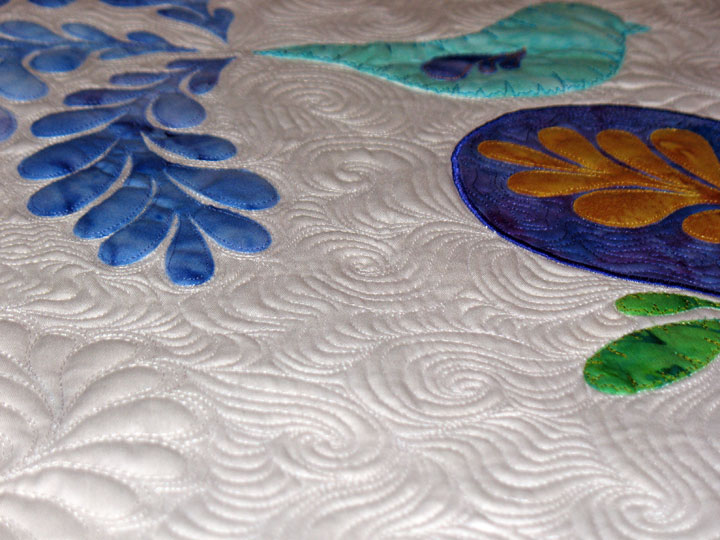
Do you see how this almost looks like the frosting on a cake? This part was easy! Instead of using a plain cotton fabric for the background, I used cotton sateen. Sateen has just a hint of a luster to it, so when you quilt it, it throws of incredible shadows. Because of that shadowing, your quilting adds an extra level of richness, kind of like going from a regular Oreo Cookie to a “Double Stuff Oreo Cookie,” and who doesn’t like that?!
Filed under
Free Motion Embroidery, Free Motion Quilting, Sizzix, Trapunto.


